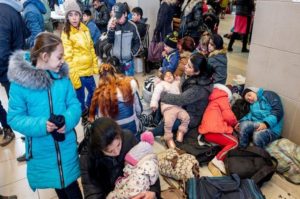Efforts to Protect Ukraine’s Children and Families
Since Russia first launched its invasion of Ukraine on Feb. 24, at least 1 million people have fled Ukraine in search of safety, according to the United Nations’ refugee agency, and half a million of that number are children. Sadly, more than 220 civilians have died thus far, including at least 15 children. Many families had already experienced the strains of life under conflict since 2014 Pramila Patten, UN Special Representative on Sexual Violence in Conflict stated it is also putting women and girls at heightened risk of violence. Ms. Patten issued a statement on Monday that stressed the importance of upholding human rights. With children and families becoming refugees in the devastated area, communities are coming together to offer aid. Last week, a band of volunteers started moving children and families from Mykolaiv and Kherson, which were the first few cities that came under attack. The volunteers grabbed any car they could borrow or rent and drove the refugees to safer, undisclosed locations. The group of volunteers, which has grown tremendously in the past few days, started driving them to the bordering countries, such as Poland and Slovakia, going by the cover of night so that they’re less conspicuous.
A nonprofit organization received permission from the Ministry of Social Welfare in Ukraine to transport kids from orphanages to safety as long as they had their birth certificates. Likewise, more than 100 Jewish refugee children were evacuated from a foster care home in Ukraine and made their way across Europe by bus and arrived in Berlin last week. The children were greeted by Jewish women from Berlin’s Chabad community who spontaneously started singing at the top of their voices to give them a joyous and warm welcome. Some of the teenagers who temporarily relocated to Germany have commented on their new surroundings and experiences. All of the following children’s last names were withheld because they are still minors. 14-year-old Maxim said, “I love Berlin, it’s beautiful. Last week we were still sitting in the bunker and the sirens were wailing nonstop.” His thirteen-year-old friend Shaul was relieved to have a peaceful place to stay, meals to eat, and friends to share conversation with.
These children have bonded with one another quickly over the shared experiences which none of them ever expected. Children have been wounded, some have lost parents, and others have witnessed violence around them. All of this has been profoundly traumatizing for them. Sixteen-year-old Nastia walks through the halls of an empty school. She has been painfully aware of conflict since 2014 and had earlier experiences of an already fragile situation. “I attended this school from the first to the second grade,” says Nastia. “Since then, I often dream in my head that I wish that time back. There were many children and teachers. It was fun here. We played, read and ran here.” Sadly the shelling, mines, and missiles have been a part of everyday life. Nastia says her younger sister is afraid of shelling and finds it difficult to talk about what’s happening. They both have been feeling increasingly anxious over the last month.
“My life is very different from the life of teenagers from peaceful regions,” she says. “They didn’t have anything like our childhoods–they didn’t hide in basements, they didn’t leave the village because of shelling, they just live. They live peacefully.”
As I hear about and read people’s stories on social media, I’m struck by one important commonality they all share. They love Ukraine, their home. Everyone who has been forced to find a safe place is leaving a bit of their heart behind because they love their country. It’s their hope to return once it is safe. Alina Chubattaya, 59, the director of a children’s home, was asked about a possible return date to Odesa. “I hope we will be back in time for Purim,” Chubattaya said, referring to the Jewish holiday which begins on the eve of March 16 this year. “You know, we Jews, we always dream of a better future,” she said. The goal is to eventually bring the children and families back to Ukraine when things are safe. “These people all want to go back to Ukraine,” she said. “Nobody’s looking to leave Ukraine.”
As Ukrainians of all ages seek support both at home and abroad, several governments have stepped up to send military and humanitarian aid. Mobile teams have been set up to provide child protection services and psychosocial care to children traumatized by the chronic insecurity caused by Russia’s invasion. There are things that can be done to help even from afar. If donating, please take time to do research before donating via social media or crowd funding websites because scamming prevails during crises like these. Still, there are pretty reliable organizations who need help. We can try donating to the Ukrainian Red Cross, the International Rescue Committee to help with on-site first aid and medical services, Voices of Children—which provides emergency psychological assistance to affected Ukrainian children, and Sunflower of Peace which has an ongoing fundraiser to prepare first aid tactical backpacks for paramedics and doctors. Making sure that we have enough supplies to support children with their basic needs, and the right people in place to support them, is a priority for these various groups, but they can use our help.


